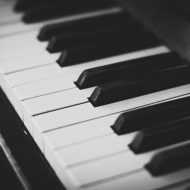Easter. Migration season. Time for that biannual church visit to top up the God points. Then, like the evanescent monarch butterfly, they disappear again until the Christmas spirit compels the return journey in December.
Ok, I’ll be honest, I just wanted to use the word evanescent in a sentence.
This presents some challenges to the garden variety church musician. Sometimes I struggle to get a band together for a normal Sunday, let alone a Good Friday service. And yet, the church will probably be fuller on Good Friday than Easter Sunday.
No, the real challenge here is picking songs. I should pick something musically impressive; perhaps five chords instead of the usual four? Nobody can resist a good old F♯m⁷♭5, right? That chord has street cred.
Perhaps not. Onwards. Let’s talk about a song we did use today.
Jerusalem
Not the one with the lifting of gates and singing. This Jerusalem is from the CityAlight album Yours Alone. The song paints an image of Jesus in Jerusalem, in the hours leading up to the cross.
See Him in Jerusalem
Walking where the crowds are
Once these streets had sung to Him
Now they cry for murder
The imagery is striking:
See the King who made the sun
And the moon and shining stars
Let the soldiers hold and nail Him down
So that He could save them
Dust that formed the watching crowds
Takes the blood of Jesus
And He stood before the wrath of God
Shielding sinners with His blood
The final verse points us towards Easter Sunday (spoiler alert):
See the empty tomb today
Death could not contain Him
Once the Servant of the world
Now in victory reigning
Arrangement
The original arrangement of the song didn’t fit our band well, so I took the liberty of raising the key a half step, and rewriting the chord progression. I was aiming for a more reflective version, to highlight the words as much as possible.
This works with just a piano and vocals. If your pianist is anything like me, you’ll want to remind them to play about half as much as they think they should.
This morning we used:
- Piano. Played throughout. Probably too much. I can say that because it was me.
- Bass. My left hand. I have a dearth of bassists.
- Acoustic Guitar. Sparingly used in the first couple of verses, and then opened up in the fourth. The challenge is to let the song breathe; the tempo at the start can ebb and flow to build and release tension. Don’t be too metronomic.
- Drums. Cymbal work early on, and then building into the fourth verse throughout the prior instrumental.
- A brace of flutes. We use our flute players like a string section or a synthesiser player. I can just throw them a chord chart and they’ll figure out what to play. Which is awesome. It also means I can’t post what they played, because it’s not written down.
- A trumpet. Mostly used to play a third above the melody in the repeated half of the last verse. As with the flutes, I try and avoid letting the melody instruments play the actual melody. It tends to muddy the waters.
- Vocals. Two female vocals, melody and harmony. Male vocals would work, but I have as many male vocalists as I have bassists.
No recording because I’m not humble enough to put one on the internet, and we also don’t have anything to record it with anyway.
